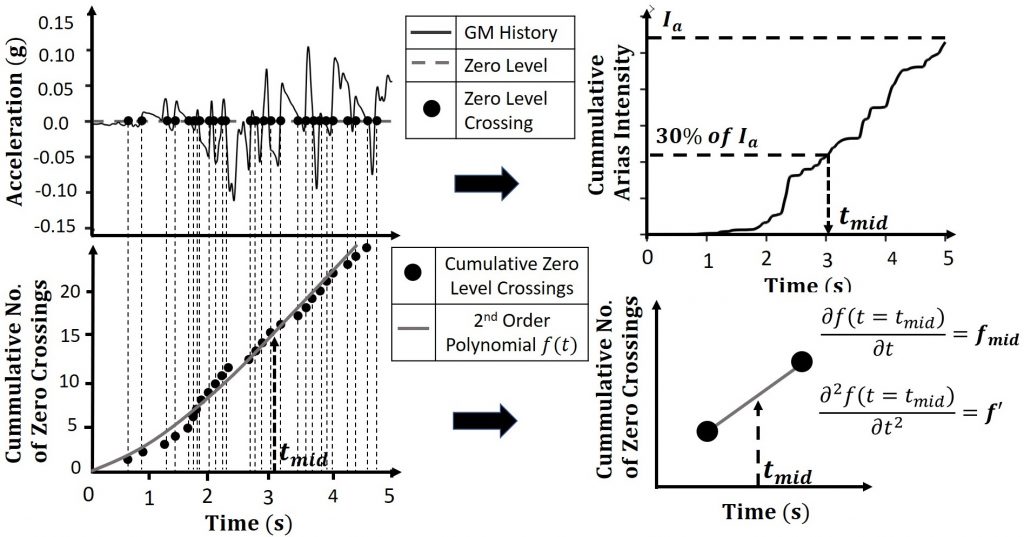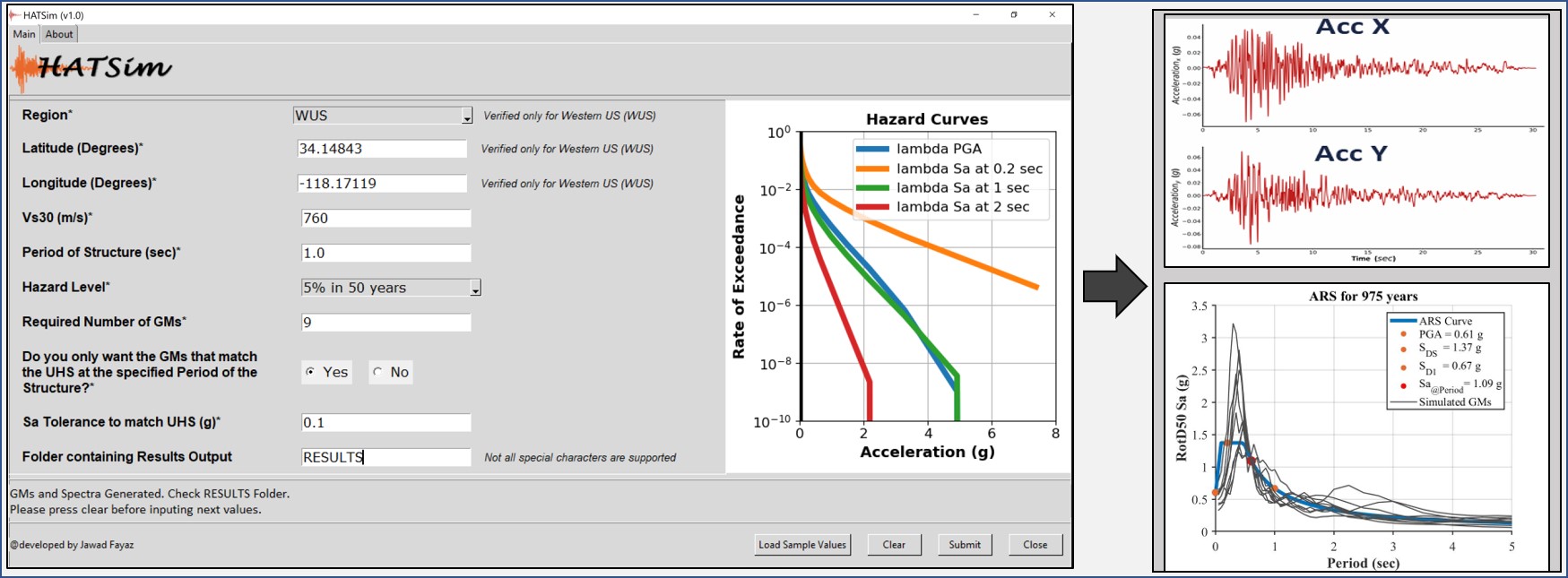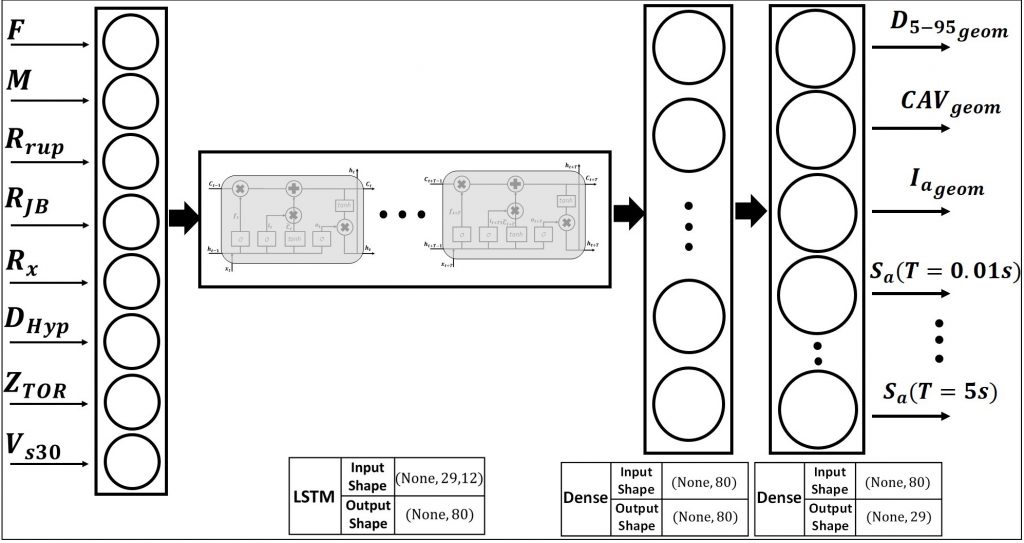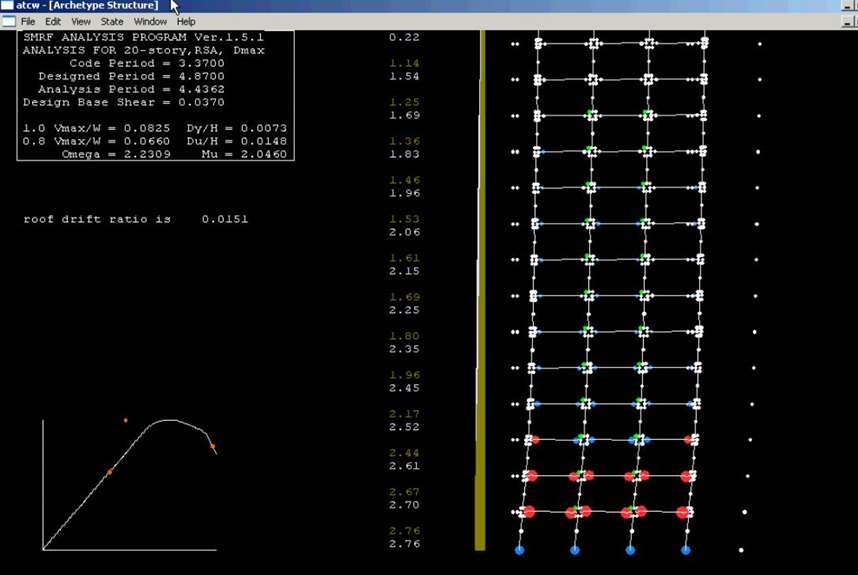Box-Girder Seat-type Bridge Models

We have working OpenSees models of three bridge models (Bridge A, B, and C) with various abutment skew angles. We will be happy to share our models,
Information about the bridges can be found here: link
Code to compute RZZ parameters

This code computes the RZZ parameters for the GMs provided by the user. The user is required to provide GM input file that contains 4 variables:
'ACC1' --> n x 1 Cell Structure containing GM history in Direction 1 (units of g)
'ACC2' --> n x 1 Cell Structure containing GM history in Direction 2 (units of g)
'DT' --> n x 1 array containing dts for the GM histories
'RRUP' --> n x 1 array containing Rrups of the GM histories (units of KM)
INPUTS:
The following inputs within the code are required:
'GM_Input_File' --> GM Input File containing the time-histories, DT and RRUP (as mentioned above)
'Results_Folder' --> Folder that will contain the output RZZ parameters
'Damping_Ratio' --> Damping Rato of SDOF
'Periods_for_Sa' --> Periods for computing Sa for both components (after rotation as per the provided reference) of GMs
OUTPUT:
The code will create 3 sub-folders inside ‘Results_Folder’ which include:
'Non_Pulse_Like_GMs' --> contains RZZ parameters and Component Sa (after rotation as per the provided reference) of GMs classified as Non-Pulse-Like
'Pulse_Like_GMs' --> contains RZZ parameters and Component Sa (after rotation as per the provided reference) of GMs classified as Pulse-Like
'Pulse_Classification' --> contains Pulse Classification parameters The indices of the results are in the same order as the provided GMs. The code will also create ‘RZZ_Params’ .mat and .xlsx files that contain the important RZZs that are useful for engineering analysis. These results are also present in the workspace variable named ‘RZZ_PARAMS’
Also, the Sa of the rotated components will be provided as ‘SA_SPECTRA’ variable and saved as ‘SA_SPECTRA.mat’
NOTE: To be efficient and prevent re-computations, before computing the RZZ parameters, the code performs a check in the ‘Results_Folder’ to see if RZZs of any GMs are already computed using the indices of the GMs. If the results are present, the code will NOT recompute the RZZ parameters for those GMs. Hence, to start fresh computations of RZZ parameters either delete the already created ‘Results_Folder’ or provide a different name for the ‘Results_Folder’ to save the results
Citation Reference: (https://doi.org/10.1785/0120200240)
Jawad Fayaz, Sarah Azar, Mayssa Dabaghi, and Farzin Zareian (2020). "Methodology for Validation of Simulat
Please contact us to receive the executable file. https://github.com/jfayaz/Compute_RZZ_Params
Hazard Targeted Time Series Simulator

This tool simulates site-based synthetic ground-motion time series using DRD (aka ADK) simulation model (Razaeian et al 2010, Dabaghi et al 2016). The inputs for Earthquake Parameters are obtained from USGS deaggregation tool and input for the Near-Fault parameters are randomized for the sources using Cybershake-UCERF2 database. The process is automated and requires minimal input from the user: 1) the structure’s lat. & long. and site’s Vs30, 2) the structure’s natural period, 3) target hazard level.
Please contact us to receive the executable file. https://github.com/jfayaz/HATSim
Generalized Ground Motion Prediction Model (GGMPM)

This tool, named as Generalized Ground Motion Prediction Model (GGMPM), uses a hybrid Recurrent Neural Network (RNN) framework to estimate a 29×1 correlated vector (denoted as IM) of RotD50 Spectral Acceleration (Sa) at 26 periods and geometric means of Arias Intensity (Ia), Significant Duration (D5-95) and Cumulative Absolute Velocity (CAV) using a set of seismic source and site parameters as inputs. The source and site inputs to the RNN framework include a vector of 12 values including F, M, Rrup, Rx, RJB, DHyp, ZTOR, Vs30,. The discrepancy between the IM vector predicted using the RNN framework and the computed from recorded ground motions is further minimized by using the Covariance Matrix Adaptation Evolution Strategy (CMA-ES). The residuals of the RNN framework are used to construct the inter-event and the intra-event covariance matrices to account for the inter-event and intra-event variabilities of the ground motions. Hence, given the source and site parameters, this tool returns a median prediction of the IM and estimated inter-event and intra-event covariance matrices. The executable is developed by Jawad Fayaz (https://jfayaz.github.io/layouts/codeandsoft.html/) and research team at University of California- Irvine (UCI). The program is named as “Generalized Ground Motion Prediction Model (GGMPM)”. For further details please read the article mentioned in the “Reference”.
GGMPM Inputs (in order)
Fault Mechanism (F)
Mechanism (F)
Strike Slip – 1
Normal – 2
Reverse – 3
Reverse Oblique – 4
Normal Oblique – 5Magnitude (Mw)
Closest Rupture Distance (Rrup) in kilometers (km)
Depth to Top of Rupture (ZTOR) in kilometers (km)
Distance Measure (Rx) in kilometers (km)
Joyne-Boore Distance (RJB) in kilometers (km)
Hypocentral Distance (DHyp) in kilometers (km)
Shear-Wave Velocity (Vs30) in meters per second (m/s)
Conditional Period (T*) in seconds (s)
Calling GGMPM:
The tool package consists of the executable application “GGMPM_Predictions.exe” which can be easily called from any command line or programming language/software. The generalized syntax to run the executable is as follows:
GGMPM_Predictions.exe F Mw Rrup ZTOR Rx RJB DHyp Vs30 T*
GGMPM Outputs:
The tool provides outputs in “RESULTS” folder (name of the “RESULTS” folder is preceded by a serial number) within the framework folder. The outputs consist of two files: 1)”GGMPM_Outputs.xlsx” excel file containing the estimated predictions and 2)”GGMPM_Sa_Spectra.jpg” picture file showing the median and sigma bands of the estimated RotD50 spectral acceleration. The excel file “GGMPM_Outputs.xlsx” includes three sheets 1)”Conditional_Predictions_log” provides the median and correlated sigma predictions of the 29 IMs in log-scale (note: the estimated median vector is correlated without any conditional period; estimated sigma vector is correlated with conditional period T* inputted by the user), 2)”IntraEvent_SigmaCov_log” provides Within-Event covariance matrix of the predictions in log-scale, and 3)”InterEvent_TauCov_log” provides Between-Event covariance matrix of the predictions in log-scale. The Intra-Event and Inter-Event variabilities are combined to provide the overall sigma vector in sheet “Conditional_Predictions_log”.
Reference:
Jawad Fayaz, Yijun Xiang, and Farzin Zareian (accepted). “Generalized Ground Motion Prediction Model (GGMPM) using Hybrid Neural Networks”. Structural Dynamics and Earthquake Engineering.
Please contact us to receive the executable file. https://github.com/jfayaz/GGMPM
Spectrally-Targeted Time-Series Simulator (SpecTSim)

Note: This tool requires a working internet connection and Matlab-Runtime (9.4) (https://www.mathworks.com/products/compiler/matlab-runtime.html) installed in the PC.
This tool simulates site-based synthetic ground-motions using DRD (aka ADK) simulation model (Razaeian et. al. 2012, Dabaghi et. al. 2018b) that matches a Target Spectrum. The tool provides two options: 1) Provide the Target Spectrum CSV file or 2) Use Uniform Hazard Spectrum (UHS) obtained from Unified Hazard Tool (2008) of USGS as the Target Spectrum. The tool uses the algorithm proposed by Fayaz and Zareian (submitted) to simulate site-based ground motion whose RotD50 spectrum naturally matches the Target Spectrum between a specified range of periods.
Instructions:
The primary inputs to this tool include: ‘Edition’, ‘Longitude’, ‘Latitude’, ‘Vs30 (m/s)’, ‘Period of Structure (T*)’, ‘Period Scale Factor 1 (PSF1)’, ‘Period Scale Factor 2 (PSF2)’, ‘Hazard Level’, ‘Required Number of GMs (n)’ and ‘Index of Agreement (IA)’. ‘Edition’, ‘Longitude’, ‘Latitude’, ‘Vs30 (m/s)’, ‘Period of Structure (T*)’, and ‘Hazard Level’ are used to obtain Deaggregation and Hazard Curves from the USGS Unified Hazard Tool (2008). The data obtained from USGS is combined with Cybershake-UCERF2 database to randomize Near-Fault Parameters (NFP) of the DRD model (Dabghi et al 2018a). These are used to simulate the ‘n’ GMs using Fayaz and Zareian (submitted). For the option: ‘Do you wish to provide Target Spectrum’, if the user selects ‘Yes’, then the options of ‘Target Spectrum file’, ‘Mw’, and ‘Rrup’ get activated. With this option, the ground motions are simulated using inputted Mw and Rrup and the inputted csv file containing the Target Spectrum is used as the target to match. An example Target Spectrum file, ‘Target Spectrum.csv’, file is provided within the folder of this tool. Column A of the csv file should contain the periods and Column B should contain the corresponding RotD50 Sa. If the user selects ‘No’, then UHS downloaded from the USGS UHT (2008) is used as the Target Spectrum. In both cases, the ground motions are simulated such that they naturally match the Target Spectrum between periods PSF1xT (sec) and PSF2xT (sec) gauged by ‘Index of Agreement (IA)’ using Fayaz and Zareian (submitted). IA values range between 0 and 1. IA = 1 means perfect match and IA = 0 means no match at all. 0.8 < IA < 0.9 is recommended for an efficient match.
Seed No.’ is an input for randomness and reproducibility; must be a whole number. It will be concatenated to the input of ‘Name of folder to contain results output’ for creating the folder for results. The format of the results folder name will be as: ‘Name of folder to contain results output-Seed No.’
USGS currently possess Hazard Curves and Deaggregation only for PGA and Periods = 0.2, 1.0, & 2.0 sec and Vs30 = 180, 259, 360, 537, 760 & 1150 m/s. Hence the Hazard Curves are generated only for these Periods and Deaggregation is conducted for the Period closest to the Period entered by the user.
Primary citation for this tool :
Fayaz J. and Zareian F. (submitted). An Efficient Algorithm to Simulate Site-Based Ground Motions that match a Target Spectrum.
Reference:
- Fayaz J. and Zareian F. (submitted). An Efficient Algorithm to Simulate Site-Based Ground Motions that match a Target Spectrum.
- Fayaz J., Azar S., Dabaghi M., and Zareian F. (2020). An Efficient Algorithm to Simulate Hazard-Targeted Site-Based Synthetic Ground Motions, Earthquake Spectra
- Dabaghi, M., Daoud, Y., and Der Kiureghian, A. (2018a). Simulation of near fault ground motions for randomized hypocenter and site locations, Proceedings of the 11th US National Conference on Earthquake Engineering, Los Angeles, CA.
- Dabaghi M., and Der Kiureghian A. (2018b). Simulation of orthogonal horizontal components of near‐fault ground motion for specified earthquake source and site characteristics. Earthquake Engineering & Structural Dynamics; 47(6):1369-1393.
- Rezaeian, S., and Der Kiureghian, A., (2012). Simulation of orthogonal horizontal ground motion components for specified earthquake and site characteristics. Earthquake Engineering & Structural Dynamics; 41(2), 335-353.
Please contact us to receive the executable file. https://github.com/jfayaz/SpecTSim
